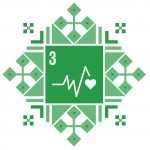September 25, 2015 at the historic Summit of the United Nations, UN member states have adopted the sustainable development agenda for the period up to 2030, in which consolidated the 17 sustainable development goals. The President of the Republic of Belarus, Alexander Lukashenko, having signed this historical document with his signature, has confirmed the desire of Belarus to achieve these goals..
![]() In the coming years, for which these universally applicable Goals should be realized, all countries of the world should intensify efforts to combat inequality, address social protection, economic growth, environmental protection and ensure well-being for all.
In the coming years, for which these universally applicable Goals should be realized, all countries of the world should intensify efforts to combat inequality, address social protection, economic growth, environmental protection and ensure well-being for all.
The Republic of Belarus has expressed a commitment to the Sustainable Development Agenda until 2030, based also on the fact that in order to ensure the sustainable development of Belarus – a young independent state – it is important to develop multilateral mechanisms to address the current challenges of our time.
As part of the ongoing work in Belarus to achieve the Sustainable Development Goals, a number of government policy documents were adopted, a management architecture was developed to achieve the Goals. The key documents in this area include the National Sustainable Development Strategy of Belarus for the period up to 2030 and the Program for Socio-Economic Development until 2020, as well as sectoral and regional programs.
To implement the overall coordination of work on the implementation of the Agenda 2030, by the decision of the Head of State, the post of National Coordinator for the achievement of the Sustainable Development Goals was established. Under the leadership of the National Coordinator, a Council on Sustainable Development was established, which included deputy heads of relevant ministries and departments, representatives of regional authorities. It is envisaged that the Council will carry out its activities jointly with parliamentarians, involving representatives of business circles, public associations and international organizations to work. Such an approach would ensure compliance with the basic principle of the Agenda 2030 – “Do not leave anyone aside.”
To monitor the achievement of the Sustainable Development Goals, it is important to obtain reliable and high-quality statistical data.
Belarus is actively working in this direction, including at the international level. Achieving the Sustainable Development Goals is undoubtedly an ambitious task that states are not able to cope with alone, mobilizing only domestic resources.
Belarus constructively participates in international cooperation in the field of sustainable development, primarily under the auspices of the UN. Through its national efforts, Belarus helps this universal organization in building international, regional and other partnerships to achieve the Sustainable Development Goals.
A project is being implemented jointly with the United Nations Development Program in Belarus aimed at supporting the activities of the National Coordinator and Parliament in achieving the Sustainable Development Goals. One of the objectives of the project is to increase public awareness on this topic.

Goal 3. Ensure a healthy lifestyle and promote well-being for all at any age
Ensuring a healthy lifestyle and promoting well-being for all at any age is essential for creating a prosperous society. However, despite significant advances in recent years in improving the health and well-being of people, disparities in access to health care still persist. Each year, more than 6 million children die before the age of five, and only half of all women in developing regions have access to the medical care they need. Ensuring health for all requires considerable effort, but the benefits outweigh the costs. Healthy people are the basis for a healthy economy. If we spend $ 1 billion to expand vaccination against influenza, pneumonia and other preventable diseases, we can save a million children’s lives a year.
Health challenges in the framework of the sustainable development goal 3
3.1 By 2030, reduce the global maternal mortality ratio to less than 70 per 100,000 live births.
3.2 By 2030, put an end to the preventable deaths of newborns and children under the age of 5 years, while all countries should strive to reduce neonatal mortality to no more than 12 cases per 1000 live births, and death rates under the age of 5 years to no more than 25 cases per 1000 live births.
3.3 By 2030, end the epidemics of AIDS, tuberculosis, malaria and neglected tropical diseases, and ensure the control of hepatitis, waterborne diseases and other infectious diseases.
3.4 By 2030, reduce by one third the premature mortality from noncommunicable diseases through prevention and treatment and the maintenance of mental health and well-being.
3.5 Improve the prevention and treatment of substance abuse, including drug and alcohol abuse..
3.6 By 2020, halve the number of deaths and injuries caused by road accidents worldwide.
3.7 By 2030, ensure universal access to sexual and reproductive health services, including family planning, information and education, and the integration of reproductive health into national strategies and programs.
3.8 Ensure universal coverage of health services, including protection from financial risks, access to quality basic health care services and access to safe, effective, quality and affordable essential medicines and vaccines for all.
3.9 By 2030, significantly reduce the number of deaths and diseases due to exposure to hazardous chemicals and pollution and poisoning of air, water and soil.
To achieve these goals you need to do the following:
3.a Strengthen, if necessary, the implementation of the WHO Framework Convention on Tobacco Control in all countries.
3.b Assist in research and development of vaccines and drugs for the treatment of infectious and noncommunicable diseases, which primarily affect developing countries, to ensure the availability of affordable essential drugs and vaccines in accordance with the Doha Declaration “TRIPS Agreement and Public Health”, which confirms the right developing countries make full use of the provisions of the Agreement on Trade-Related Aspects of Intellectual Property Rights in Regarding flexibility for the purpose of protecting public health and, in particular, ensuring access to medicines for all.
3.c Substantially increase health financing and the recruitment, development, training and retention of health workers in developing countries, especially in least developed countries and small island developing states.
3.d Build the capacity of all countries, especially developing countries, in the field of early warning, risk reduction and national and global health risk management.
Public health as a factor in the development of society
The Republic of Belarus is making significant efforts to address the objectives of Goal 3, “Ensuring a healthy lifestyle and promoting well-being for all at any age”.
The UN / UNDP mission in 2013 noted Belarus’s achievement of the Millennium Development Goals to reduce child mortality, improve maternal health, combat HIV / AIDS, malaria and tuberculosis (Goals 4, 5, 6).
Thanks to the conditions created for the birth of healthy children, the reduction of child disability, the reduction of infant, child and maternal mortality, the maternal mortality rate in Belarus decreased by more than 18 times from 1990 to 1.7 per 100,000 live births .
The infant mortality rate in 2016 reached a level of 3.2 per 1,000 live births, taking into account children with a birth weight of 500 grams. By this indicator, the Republic of Belarus is at the level of the developed countries of Europe (3.69 per mille) and is ahead of the CIS countries (9.34 per mille). Belarus occupies the 25th position in the rating of the most comfortable countries for motherhood.
There is a decrease in the death rate of children under 5 years of age, which by 2016 was reduced to 4.1 per 1000 live births versus 15.6 in 1990. According to the 2014 UNICEF report, Belarus has the best indicator in the CIS in terms of infant mortality. According to the UNFPA information, at the end of 2014, Belarus took the 1st place in the world to reduce the maternal mortality rate and was among the 42 countries in which, in 100% of cases, birth is carried out by qualified medical personnel.
Thanks to the implementation of the State Program “People’s Health and Demographic Security of the Republic of Belarus” for 2016–2020 and HIV prevention programs in partnership with international organizations (UNAIDS, UNDP, UNICEF) and non-governmental organizations with the support of the Global Fund in the country for the last 10 years it was possible to achieve a significant reduction in the spread of HIV
The incidence of HIV infection in the Republic of Belarus in 2016 was 25.2 cases per 100 thousand population and is kept in a concentrated stage, i.e. HIV prevalence prevails among the most vulnerable groups of the population: among injection drug users (13.8%), women involved in sex work (5.8%), and men who have sex with men (4.8%) .
The prevalence of HIV in the population as of January 1, 2017 was 0.18%. The coverage of antiretroviral treatment of HIV-positive patients is increased to 49% of the number registered at the dispensary registration.
In 2016, the Republic of Belarus received a WHO certificate, fixing the complete prevention of transmission of HIV infection and syphilis from mother to child.
In Belarus, in October 2016 – February 2017, a large-scale representative STEPS study was conducted to study the prevalence of risk factors for non-communicable diseases (smoking, alcohol consumption, overweight, hypodynamia, high blood pressure, elevated glucose and cholesterol, increased salt) . The results of the study will contribute to building national capacity to analyze and interpret the STEPS data set in order to improve the surveillance of non-communicable diseases in the Republic of Belarus, and also allow developing a set of measures to combat the most common non-communicable diseases in the country.
The health system provides universal health care coverage, access to safe, effective and high-quality medicines and vaccines.
Re-equipment of the latest medical equipment has significantly increased the level of provision of citizens with previously inaccessible types of medical services based on the latest achievements of world medical science.
By the number of organ transplants per 1 million of the population, Belarus is a leader not only in the post-Soviet space, but also ahead of many European countries. There are 50 transplants per million population in the country.
A complex problem is the prevention of bad habits and the formation of motivation for a healthy lifestyle. An analysis of the causes of mortality in Belarus shows that non-communicable diseases today account for about 90% of all deaths. It is this factor that determines the main vector of application of efforts for the near and medium term. The issues of prevention, quality and timely treatment and rehabilitation of patients with circulatory system diseases, cancer, diabetes, and obstructive pulmonary diseases come to the fore. It is necessary to minimize, and ideally – to exclude the impact on the human body of such risk factors as tobacco, alcohol, irrational unbalanced diet, physical inactivity.
The full text of the document “Starting Positions of Belarus on Achieving the Sustainable Development Goals” is available below.

